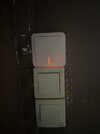I have a couple of these
which are working fine, but the neons have gone dim. To save the expense of new ones (they are a non-standard size), is it possible to get replacement mains voltage neons? I have an idea they have a resistor in the connecting wire to drop the voltage.
I realise that there have been many responses to this question and I am sorry if this has been covered by anyone else but the answer as to why these "neon" indicators dim or "fail" is the quality of the resistors limiting the current through them.
The resistors concerned need to be in the range of up to Megohms!
These are difficult to make for the few cents/pence usually expected.
Unfortunately, manufacturers tend to use the relatively cheap "carbon granule" resistors, which initially have the correct resistance value but they depend on "point contacts" between the individual granules to provide this resistance. In operation, some of these point contacts tend to go "open circuit", which results in a higher value of resistance and a cascading effect, resulting in the open circuiting of more point contacts - and so on.
The solution is to use better quality (metal film) "dropping resistors".
This brings to mind the situation when we had TVs with cathode ray tubes, which required both vertical and horizontal deflection.
My memory is now a bit rusty but some vertical deflection circuits in these TVs involved one or two quite high value resistive components.
When these cheap resistors crept "high", the vertical deflection would shrink.
When replacing them, apart from using the best quality that I could obtain, if space was available I often replaced one of these with four in series parallel, to reduce the stress on each component - which probably gave the TV more than four times its expected life, as determined by that problem.


